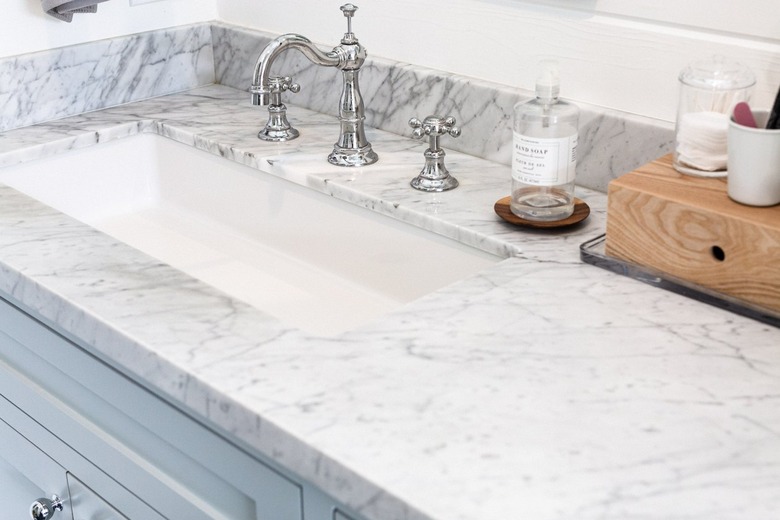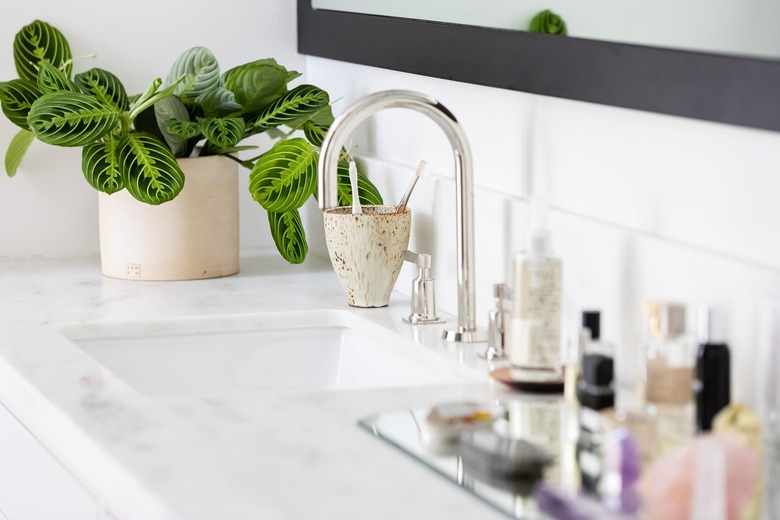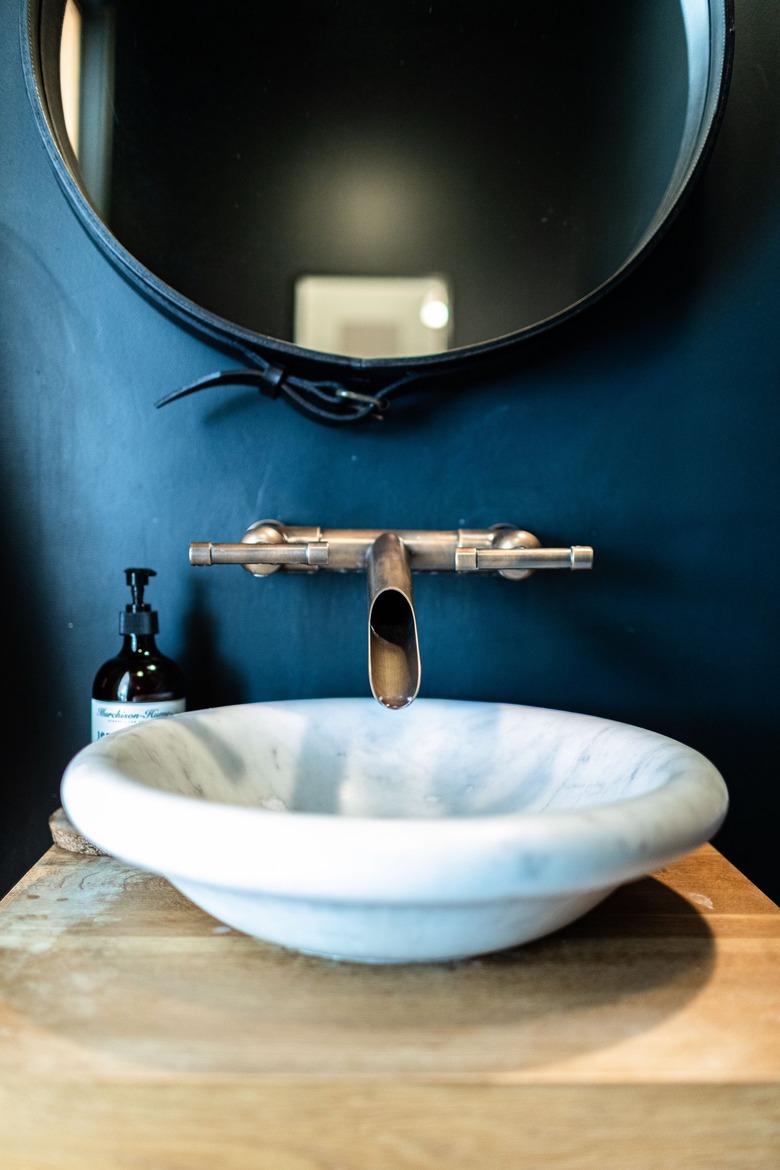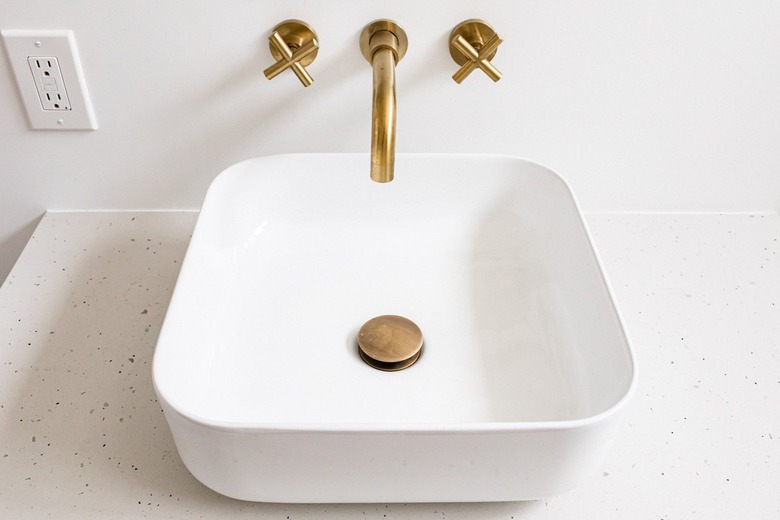Best Finish Materials For Bathroom Faucets
No bathroom remodel is complete until the final bathroom fixtures have been installed. In fact, many people are surprised by just how much something as seemingly minor as their choice of bathroom faucet finish can impact the entire bathroom's appearance.
Buying a cheap bathroom faucet with a finish that will quickly tarnish can make an otherwise lavish sink and countertop look dramatically less attractive, whereas a high-quality faucet finish can make a midrange bathroom vanity look drastically more luxurious. Just changing the majority of your bathroom fixtures, including your sink faucet, tub or shower faucet, showerhead and bathroom accessories (towel rack, vanity hardware, toilet paper holder, etc.) so they all have the same finish can make your entire bathroom instantly look more refined.
A Note on Faucet Materials
A Note on Faucet Materials
Keep in mind that finishes can be applied to many kinds of metal or plastic, so always check the interior bathroom faucet material before making a purchase. A solid brass faucet is an expensive option, but these are dense and heavy, which means it will be likely to last for a long time without leaking or corroding. A stainless steel faucet is also a good option that is unlikely to corrode or leak, but they aren't as sturdy as brass, though they are less expensive. Zinc is cheaper but will corrode when in contact with water. The majority of metal faucets sold by reputable manufacturers come with a lifetime warranty just in case something goes wrong.
If you're buying a salvaged bronze faucet made prior to 1994, be warned that it may have as much as 8 percent lead. A law passed in 2014 prohibits the manufacturing of faucets that contain more than .25 percent lead, which is obviously a dramatic improvement. That being said, the National Institute of Environmental Health Sciences says no amount of lead is safe, so if you are concerned about lead exposure, you may prefer buying a plastic faucet that will be totally lead-free. These are less expensive, but their quality is not as high, and they will need to be replaced sooner. Unlike a high-quality metal faucet, they will not come with a lifetime warranty.
Silver-Toned Bathroom Faucet Finishes
Silver-Toned Bathroom Faucet Finishes
Silver-toned bathroom faucet finishes are more popular than gold shades because they are neutral and work with just about any decor. While chrome is the most common bathroom faucet finish, nickel is considered a step up, and stainless steel has been gaining popularity in the bathroom. While some people think these three look the same, nickel is a bit darker than chrome, and stainless steel has more blue undertones. Although each finish has its own benefits, many people prefer the unparalleled soft, durable and spot-resistant qualities of brushed nickel.
Polished Chrome
Once considered to be nothing more than a cheap option for those who didn't want to invest in their bathroom decor, chrome has been shedding its stigma and is now seen even in high-end homes. Even so, it remains one of the most affordable (you can find chrome faucets for under $15) and most widely available of all finishes, and the mirrored surface is versatile and matches practically all bathroom decor, looking fantastic under all lighting.
- Pros: Difficult to scratch and resistant to rust and corrosion, chrome is the cheapest of all finishes and is easy to clean with mild cleansers and a damp towel. Styles are available for all budgets and decor themes. Chrome can be found anywhere, and it matches well with other finishes.
- Cons: Chrome needs to be cleaned frequently to remove fingerprints and water spots. When compared with polished nickel, most people prefer the appearance of nickel.
Polished Nickel Finish
Polished nickel is darker, warmer and more complex than chrome. In fact, you may notice that the same faucet may look slightly different under different lighting. It is neutral enough to fit in with just about every decor style, but it also has more depth than polished chrome. This is because the nickel is often plated over materials like brass that can add pale golden undertones.
- Pros: Polished nickel is easy to clean with mild cleanser and a damp towel. It is more impressive looking, is shinier than chrome and is one of the most durable of all finishes.
- Cons: Polished nickel can be as much as 10 times the price of chrome and is also more expensive than brushed nickel. It tends to show fingerprints and water
spots.
Brushed Nickel
As the name implies, brushed nickel, also known as satin nickel, is treated with a wire brush, which gives it a matte appearance. It is becoming more and more popular because it hides fingerprints and water spots. Many people find that it looks more luxurious than its high-shine counterparts, but it is fairly midrange in price.
- Pros: Brushed nickel is easy to clean, available in a wide array of
styles, reasonably inexpensive (though more expensive than chrome or stainless
steel) and easy to match with most other finishes. Brushed nickel is arguably the
most durable finish on the market. Plus, it doesn't show water spots or fingerprints. - Cons: Brushed nickel doesn't pair well with stainless steel fixtures and
accessories. It needs to be wiped down regularly and should not be cleaned with abrasive cleansers, or the finish may tarnish.
Polished Stainless Steel
The tried and true king of faucet finishes, stainless steel has been increasingly moving from the kitchen to the bathroom. Like nickel, stainless steel is generally considered a step up from chrome. That's because it has more complexity of colors with its blue undertones and because it is more durable.
- Pros: Stainless steel is less expensive than almost all other materials, with the exception of chrome. It is very
resistant to corrosion. - Cons: Stainless steel shows water spots and fingerprints, though less so
than chrome. It scratches easily, so always use gentle cleansers. It doesn't match
most other bathroom fixture finishes.
Gold-Hued Bathroom Faucet Fixtures
Gold-Hued Bathroom Faucet Fixtures
Copper and bronze and brass, which are alloys made from copper, are not only attractive with their warm hues but they are also naturally antimicrobial. In fact, the Conversation notes that copper alloy surfaces have been shown to kill as much as 90 percent of live bacteria, including dangerous pathogens such as MRSA, E. coli and more, which can obviously be quite beneficial in a bathroom sink faucet.
Each of these materials offers its own benefits but also has its own unique color. Brass is a yellow metal that is similar to gold, copper features a more red hue and bronze has more of a brown color. Overall, gold-tinted bathroom faucet finishes are more expensive than silver-toned finishes.
Polished Brass
The classic go-to for those who want gold fixtures in their bathroom, polished brass always attracts attention. While it has long been a staple of bathrooms with a vintage flair, in recent years, polished brass has been catching on again, making it increasingly popular with modern designs.
- Pros: Just like sold brass faucets, brass finish is particularly durable and won't rust or corrode. They are easy to clean and can mix well with other materials to create an eclectic yet cohesive look in the bathroom.
- Cons: It is one of the more expensive finish options overall. The protective lacquer that prevents it from tarnishing or growing a patina may dull over time. The high-shine finish shows
fingerprints and water spots.
Satin Brass
If you like the golden color of polished brass but want something a little more muted, satin brass (also called "champagne bronze") is a great alternative. It captures the warm appearance of brass without the shine, allowing it to work with a wide array of bathroom decor styles, ranging from classic farmhouse all the way to modern decor.
- Pros: Satin brass doesn't look as flashy as polished brass, but it still looks elegant and warm, making it more versatile than polished brass. The matte finish
doesn't show fingerprints or water spots. - Cons: Satin brass isn't as easy to find as polished brass,
and as a result, it is one of the most expensive finish options and may come
in fewer styles.
Oil-Rubbed Bronze
For a darker, more romantic color that still looks upscale, oil-rubbed bronze adds a great ambiance and a touch of texture. This is the most popular of all bronze finishes, with good reason. It is dramatic and striking, and while most people associate it solely with rustic styles like cottage, Tuscan and old-world decor, it is a great way to add a little drama to any traditional style.
- Pros: Oil-rubbed bronze is durable and easy to care for since it will not show fingerprints or water spots.
- Cons: Different manufacturers' oil-rubbed bronze may look different from one another, so if you are thinking of buying your showerhead, faucets and drains from different manufacturers, you may need to check ahead of time to ensure that they all match.
Satin Bronze
Do you think brass and oil-rubbed bronze are both too dramatic? You can find a more muted option with satin bronze (also called "brushed bronze"), which is a matte version of natural bronze. Its mellow, brown hues add a more nature-inspired tone to your bathroom. Satin bronze works with a wide array of bathroom styles, but like its oiled cousin, it is most closely associated with Mediterranean decor.
- Pros: The satin finish is easy to clean with a mild cleanser and a soft cloth. Because it doesn't show water spots or fingerprints, it doesn't need to be cleaned as frequently. Overall, bronze is durable and easy to maintain.
- Cons: The darker color doesn't play well with many other metal finishes, so you might need to deck out your whole bathroom in bronze, which some people might find too matchy-matchy. Also, it's a somewhat rare finish, so it can be hard to find and can cost more.
Copper
With its red and gold tones, copper is classic, warm and bold. It doesn't work with everything, but when it is paired with soft, neutral colors — particularly dramatic whites and blacks — it stands out in an incredible way. Like polished brass, it is most closely associated with traditional, rustic and natural styles, but it increasingly works with more modern styles as well.
- Pros: Copper is unforgettably unique-looking. It is the most naturally anti-microbial of all metals, so it will naturally disinfect itself to some extent. It develops a lovely patina over time.
- Cons: If you don't like the natural patina of copper, it
takes a lot of maintenance to protect the shine you'll find in a new faucet. It scratches easily, though scratches in the patina may heal and blend in with the rest of the finish eventually. Copper is hard to match with other finishes and is only available in limited styles.
Matte Black Finishes
Matte Black Finishes
In recent years, matte black finishes have become increasingly popular, offering a unique alternative to metal finishes. Luxury brands have been offering quite a few contemporary designs with this finish, but more mainstream brands offer both contemporary and traditional-styled faucets and accessories in a matte black finish.
- Pros: Matte black finish is exceptionally versatile and matches just about all other accessories. It is easy to clean and doesn't show dirt, grime, water spots or
fingerprints. - Cons: It can be more expensive than most metal finishes, though
comparable to brass.
PVD Bathroom Faucet Finishes
PVD Bathroom Faucet Finishes
When looking at bathroom faucet finishes, you might notice that some faucet finishes are labeled "PVD," while others are not even though they look exactly the same. That's because "PVD" means "physical vapor deposition" and doesn't describe the material of the finish at all but rather the application method used to secure the finish to the faucet, which is far more complex than the standard finish application.
The PVD application process involves the use of a vacuum chamber and a high-temperature plasma. While these faucets tend to be a bit more expensive, if you ask designers, contractors or plumbers, they'll almost certainly agree that PVD is the best bathroom faucet finish option and is entirely worth the price, as it is more resistant to scratching, corrosion and most cleaners.
It's worth noting that many companies rename their PVD finish with some kind of marketing jargon. For example, a Delta faucet with PVD finish is called "brilliance," Moen calls it "lifeshine" and Kohler calls it "vibrant." Also, some companies have limited selection when it comes to PVD faucets. In fact, American Standard only offers PVD faucets in stainless steel and polished nickel, and Premier Faucet only sells what is called "PVD brushed nickel."
Similarly, some companies will have fewer designs available, though if you want a basic single-handle or centerset faucet with a PVD finish, you'll probably be able to find a design you like.
- Pros: It is resistant to scratches, corrosion, staining, abrasive
cleansers and even steel wool. A PVD finish
will last years longer than a typical non-PVD finish. - Cons: It is more expensive. PVD faucets can sometimes be damaged
by certain household chemicals, such as corrosives and those used to remove
tarnish or rust.
References
- Trade Winds Imports: 5 Bathroom Faucet Finishes Explained
- Networx: Comparing Bathroom Fixture Metals Choices
- Kingston Brass: Buyer's Guide: The Best Materials for Bathroom Faucets
- California Faucets: PVD
- Cheviot: Nickel, Chrome or Steel? Tips for Using Silver Fixtures in the Bathroom
- Delta: How to Choose Bathroom Faucet Finishes
- Faucets Rated: Chrome vs Stainless Steel Faucet – Which Is Better?
- Palmer Industries: What is a PVD Finish?
- Copper Development Association: Antimicrobial
- Crawford Supply: Choosing Between 9 Different Fixture Finishes
- The Washington Post: How to Deal with Corrosion on Brushed Nickel Faucets
- National Institute of Environmental Health Sciences: Lead and Your Health
- The Conversation: Copper Is Great at Killing Superbugs – So Why Don't Hospitals Use It?



